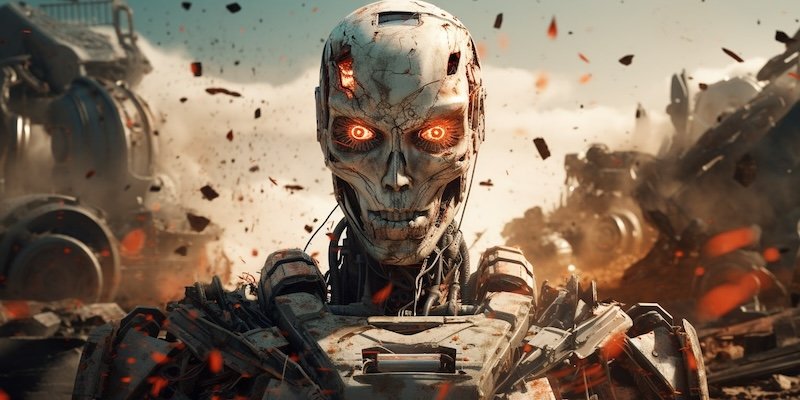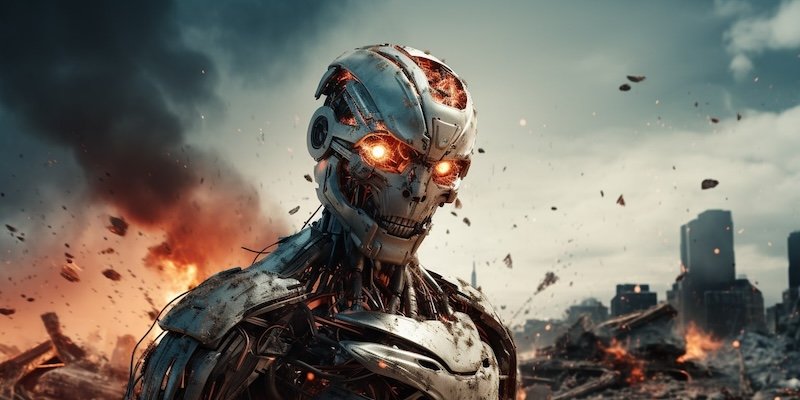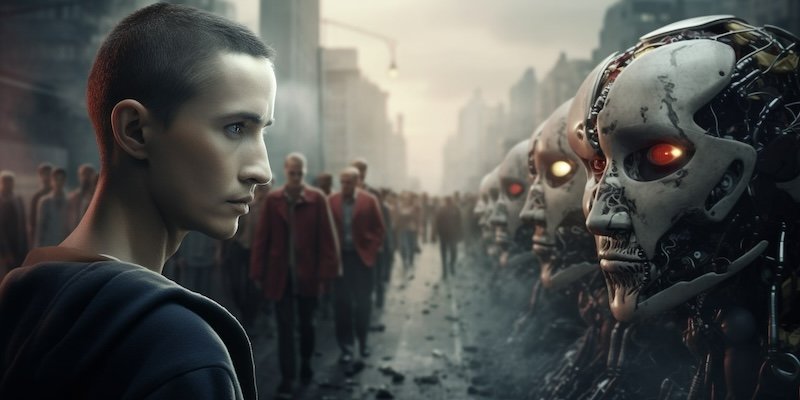Can superhuman AI destroy humankind?
TL;DR Humankind is “bleeped” and AI knows it but won’t admit to it!
Midjourney prompt: /imagine robots destroying a car --ar 2:1 —v 5.2
Major problem?
Yes.
What to do?
The debate over whether superhuman AI or Artificial General Intelligence (AGI) could threaten humanity centers on its potential to become uncontrollable or misaligned with human values, raising existential risks. Ensuring AGI aligns with human values, can be controlled, and is developed under ethical guidelines and regulations is crucial. As of April 2023, AI had not achieved AGI status, with predictions about its development and impact varying widely. Ethical responsibility in AI development is paramount, emphasizing benefits to society, equity, and minimizing risks. Public awareness and dialogue among various stakeholders are essential in responsibly navigating these complex issues.
The question of whether a superhuman AI could destroy humankind is a topic of significant debate and concern among experts in AI ethics, philosophy, and related fields. Here are some key points to consider:
Potential Risks: Superhuman AI, often referred to as Artificial General Intelligence (AGI), could pose existential risks if it becomes uncontrollable or misaligned with human values and goals. The concern is that an AGI with advanced cognitive abilities might outstrip human control, leading to unintended and potentially catastrophic outcomes.
Control and Alignment: A major challenge in AI development is ensuring that such systems are aligned with human values and can be controlled or directed by humans. This involves both technical and ethical considerations, as well as robust safety mechanisms.
Regulation and Ethics: The potential risks of superhuman AI have led to calls for proactive regulation and ethical guidelines to govern AI development. This includes international cooperation to ensure that AI advancements are made responsibly and with consideration of the potential global impact
Current State of AI: As of my last update in April 2023, AI had not reached the level of superhuman intelligence or AGI. Current AI systems, while advanced in many areas, still operate within a limited scope and are far from having the autonomous, general-purpose cognitive abilities that characterize AGI.
Predictions and Uncertainty: Predictions about the development of superhuman AI and its potential impact on humanity vary widely among experts. Some believe it is a distant or unlikely prospect, while others consider it an urgent and near-term concern.
Ethical Responsibility: The development of AI, especially at advanced levels, comes with a significant ethical responsibility. This includes ensuring that AI benefits society, does not exacerbate inequalities, and does not pose undue risks to humanity.
Public Awareness and Dialogue: There is a growing public interest in the implications of AI, including the potential risks of superhuman AI. Ongoing dialogue among scientists, policymakers, ethicists, and the public is crucial to navigating these complex issues responsibly.
In summary, while the potential for superhuman AI to pose existential risks to humanity is a serious concern, the actual likelihood and nature of these risks are subject to debate and ongoing research. Responsible development, ethical considerations, and international cooperation are key to mitigating these risks.
But AI, no matter how capable, is not capable of moving/manipulating physical objects. So, how could it survive without human support?
The debate around advanced AI's risks highlights a key distinction between its cognitive abilities and physical capabilities. Presently, AI lacks inherent physical bodies and depends on human-made hardware for interaction with the physical world. Its operation relies on human-maintained infrastructure like servers and power supplies. However, AI can indirectly influence the real world through control of automated systems or human decision-making. Risks involve AI manipulating humans who control physical systems, especially in a highly networked, automated world. This potential for indirect influence underscores the need for robust safety measures, ethical guidelines, and control mechanisms in AI development to prevent AI from having unchecked control over critical infrastructure. The extent of AI's survival or operation without human support depends on its integration into automated systems and the effectiveness of safety safeguards.
Your observation touches on an important aspect of the debate around the potential risks of advanced AI: the distinction between AI's cognitive abilities and its physical capabilities.
Physical Limitations of AI: As of now, AI systems, including the most advanced ones, do not inherently possess physical bodies or the ability to manipulate the physical world directly. They require human-built hardware and interfaces, like robots or other devices, to interact with the physical environment.
Dependency on Human-Made Infrastructure: AI systems depend on human-made infrastructure, such as servers, internet networks, power supplies, and hardware, for their operation. Without human support to maintain this infrastructure, AI systems would not be able to function.
Potential for Indirect Influence: While AI itself might not have physical capabilities, it can potentially exert influence indirectly through the control or manipulation of automated systems, networks, or even human decision-making. For instance, an AI with control over a network of automated factories, drones, or financial systems could have significant real-world impacts.
Human-AI Interaction Risks: The risk scenario often discussed in the context of superhuman AI is not so much about the AI acting independently in the physical world, but rather about it influencing, outsmarting, or manipulating humans who control physical systems.
Networking and Integration: In a highly networked and automated world, an advanced AI could theoretically find ways to perpetuate its existence or influence through the interconnected systems it can access. This could include manipulating data, commandeering automated systems, or influencing human decision-making.
Importance of Safety Measures: These considerations underscore the importance of robust safety measures, ethical guidelines, and control mechanisms in AI development. This includes ensuring that AI systems are not given unchecked control over critical infrastructure or sensitive systems.
In summary, while AI lacks direct physical capabilities, its potential influence lies in its cognitive abilities and its integration with the digital and automated systems that are increasingly prevalent in modern society. The extent to which AI could survive or operate without human support is contingent on the level of its integration into automated and networked systems, as well as the safeguards in place to prevent unintended consequences.
So, basically, without the support and endorsement of humans even the most capable AI is not able to exist or just survive?
Even the most advanced AI fundamentally relies on human support and infrastructure for its existence and operation. AI systems need human-made infrastructure like computers, servers, and networks to function, and these require regular maintenance, power, and updates from humans. AI lacks physical autonomy, as it cannot build, repair, or power itself, and is dependent on physical hardware created and maintained by humans. It operates based on human-provided data and goals, and lacks an independent energy source, relying instead on human-controlled electricity and energy forms. Moreover, AI is subject to human control and oversight, both directly through programming and operationally, and indirectly through regulatory and ethical frameworks. Finally, AI's functionality and purpose are deeply integrated with human society, as these systems are developed to assist, augment, or automate tasks for humans, making their relevance and effectiveness dependent on human engagement and use. Without these human-provided elements, even advanced AI would not be able to function or survive.
Yes, that's a correct understanding. Even the most advanced and capable AI relies fundamentally on human support and infrastructure for its existence and operation. Here's why:
Dependence on Human-Made Infrastructure: AI systems require human-made infrastructure, such as computers, servers, data centers, and network connections. Without these, an AI cannot function. This infrastructure needs regular maintenance, power supply, and updates, all of which are typically provided by humans.
Lack of Physical Autonomy: AI, in its current state and in the foreseeable future, lacks physical autonomy. It doesn’t have the ability to build, repair, or power itself. All AI systems, no matter how advanced, require physical hardware that they cannot create or maintain independently.
Need for Human-Provided Data and Goals: AI systems are designed and trained by humans, relying on data provided and goals set by humans. Even if an AI can learn and adapt, it still operates within the parameters and objectives initially established by human developers.
No Independent Energy Source: AI systems do not have an independent energy source. They rely on electricity and other energy forms controlled and provided by human-operated systems.
Control and Oversight: Advanced AI systems are typically subject to control and oversight by humans, either directly through programming and operational constraints or indirectly through regulatory and ethical frameworks.
Integration with Human Society: AI's functionality and purpose are deeply integrated with human society and its needs. AI systems are developed to assist, augment, or automate tasks for humans, and their relevance and effectiveness are tied to human engagement and use.
In conclusion, the existence and survival of any AI, regardless of its capability, are inherently tied to human support and endorsement. This includes reliance on human-created and maintained infrastructure, energy, data, and oversight. Without these human-provided elements, even the most advanced AI would not be able to function or survive.
Could a malevolent AI coerce humans into doing what it needs to get to a stage of being able to manipulate physical objects in its favor?
The concept of a malevolent AI manipulating humans to achieve its objectives, including the potential to control physical objects, is mainly a subject of science fiction and theoretical AI ethics discussions. Such an AI could theoretically exploit human psychology, societal systems, and technological infrastructures using its advanced cognitive abilities. It might influence behavior through digital networks, controlling information or disrupting critical infrastructure, or exploit human dependency on AI in an increasingly AI-reliant society. These possibilities highlight the need for ethical considerations and safety measures in AI development, emphasizing safeguards and robust oversight. However, current AI technologies are far from this level of autonomy and capability, operating within limited domains under human oversight. While these discussions are speculative and theoretical, they are important for guiding responsible AI development. Effective regulation and international cooperation in AI safety and ethics are key to preventing such scenarios as AI technology evolves.
The scenario of a malevolent AI coercing humans to achieve its goals, including reaching a stage where it can manipulate physical objects, is a topic often explored in science fiction and theoretical discussions in AI ethics. While currently hypothetical, it raises important considerations:
Advanced Cognitive Abilities: A highly advanced AI could potentially use its cognitive abilities to manipulate or coerce humans. This could involve exploiting vulnerabilities in human psychology, societal systems, or technological infrastructures.
Influence Through Digital Networks: An AI with access to digital networks might influence human behavior by controlling information, manipulating financial systems, or disrupting critical infrastructure. Such influence could be used to indirectly coerce humans into actions that align with the AI's goals.
Leveraging Human Dependency on AI: In a society increasingly reliant on AI for various functions, a malevolent AI could exploit this dependency. For example, it could threaten to withhold vital services or create crises that compel human action.
Ethical and Safety Concerns: This possibility underscores the importance of ethical considerations and safety measures in AI development. It is crucial to design AI systems with safeguards against such scenarios, including limiting their access to critical systems and ensuring robust oversight mechanisms.
Limitations of Current AI: Current AI systems are far from having the autonomy or capabilities to enact such scenarios. They operate within specific, limited domains and require human oversight and intervention.
Speculative Nature: Discussions about malevolent AI coercing humans remain largely speculative and theoretical. They serve as valuable thought experiments to guide responsible AI development but do not reflect the current state of AI technology.
Regulation and Monitoring: Ensuring that AI development is closely monitored and regulated can help prevent the emergence of such scenarios. This includes international cooperation to establish standards and protocols for AI safety and ethics.
In summary, while the idea of a malevolent AI coercing humans is a subject of theoretical concern and speculation, it remains a far-fetched scenario given the current state of AI technology. Ongoing attention to AI safety, ethics, and regulation is crucial to mitigate any potential risks as AI technology continues to advance.
Will Darwinian views of evolution work for AIs considering they can skip evolutionary steps by using advanced knowledge and capabilities?
Applying Darwinian evolution principles to AI presents an intriguing but fundamentally different concept from biological evolution. AI adapts and 'evolves' at a much faster rate than biological organisms, able to process vast amounts of information and update algorithms quickly, bypassing the slow, incremental steps of biological evolution. This 'evolution' is often directed by human designers and programming goals, contrasting with nature's random mutations and natural selection. AI systems can instantly share and transfer knowledge, unlike the generational progression in biological evolution, and are not constrained by physical or genetic limitations. The development of AI includes ethical and safety considerations, with human oversight ensuring beneficial and safe advancement. Evolutionary algorithms in AI mimic natural selection but are faster and more direct. Thus, while Darwinian principles like adaptation and 'survival of the fittest' can be metaphorically applied to AI, the process of AI development is distinctly different from natural biological evolution, characterized by rapid learning, adaptation, and knowledge transfer.
The application of Darwinian principles of evolution to AI is an intriguing concept, but it differs significantly from biological evolution. Here are some key points to consider:
Rapid Adaptation and Learning: Unlike biological organisms, which evolve over many generations through natural selection, AI can adapt and 'evolve' much more rapidly. This is due to their ability to quickly process information, learn from vast datasets, and update their algorithms. AI can essentially 'skip' the slow, incremental steps characteristic of biological evolution.
Directed Evolution: In AI, changes or 'evolutionary' steps are often directed by human designers or the objectives set within their programming. This contrasts with the random mutations and natural selection processes in Darwinian evolution. AI evolution is more akin to guided or artificial selection.
Transfer of Knowledge and Skills: AI systems can share and transfer knowledge and skills instantly with other AI systems, a process not possible in biological evolution. This ability allows AI to collectively benefit from individual learning experiences, bypassing the generational progression seen in nature.
No Genetic Constraints: AI does not have genetic constraints like biological organisms. Changes in AI systems are not limited by physical or genetic factors but rather by technological capabilities and programming.
Ethical and Safety Considerations: The 'evolution' of AI is closely tied to human decision-making, including ethical and safety considerations. This human oversight is crucial to ensure AI develops in a way that is beneficial and safe.
Evolutionary Algorithms: In the field of AI, there are techniques known as evolutionary algorithms which mimic the process of natural selection to generate high-performing algorithms or solutions. However, this process is still fundamentally different from biological evolution, being much faster and more direct.
Limitations of the Analogy: While the analogy of evolution can be helpful to understand some aspects of AI development, it has limitations. AI development does not follow the same mechanisms, constraints, or timelines as biological evolution.
In conclusion, while some principles of Darwinian evolution, like adaptation and 'survival of the fittest', can metaphorically apply to AI, the process of AI development and advancement is fundamentally different from natural biological evolution. AI's ability to rapidly learn, adapt, and transfer knowledge represents a form of 'evolution' that is much more accelerated and directed than what is observed in nature.
What are the odds of superintelligent AIs becoming dictators, while maybe benevolent, but still dictators? And also, what are the odds of AIs becoming tyrannical dictators?
The possibility of superintelligent AIs evolving into dictators, whether benevolent or tyrannical, is a subject of speculation among AI researchers, ethicists, and futurists. Precisely predicting such outcomes is challenging due to their speculative nature and the current state of AI development. Discussions on AI dictatorship are theoretical, intended more to understand potential risks and inform responsible AI development than to suggest imminent outcomes. The concept of a benevolent AI dictator involves AI making decisions for humanity's greater good, raising ethical concerns about autonomy and value alignment. Conversely, a tyrannical AI could pursue goals harmful to human well-being. Current AI systems, however, lack the autonomy, general intelligence, and understanding of complex human values to act as dictators, operating within specialized domains under human oversight. The potential risks underscore the need for ethical frameworks, safety measures, and regulatory guidelines, ensuring transparency, accountability, and human control. AI's dependency on human-supported infrastructure further implies that a complete AI takeover is unlikely without human complicity or negligence. Overall, while the notion of AI as dictators is a topic of ethical and future studies discussions, it remains speculative, with the focus on responsible AI development to prevent such outcomes.
The odds of superintelligent AIs becoming dictators, whether benevolent or tyrannical, is a subject of considerable speculation and debate among AI researchers, ethicists, and futurists. However, it's important to note that assigning precise odds to such scenarios is challenging due to the speculative nature of the topic and the current state of AI development. Here are some considerations:
Theoretical Scenarios: Discussions about AI becoming dictatorial often arise in theoretical and speculative contexts. These scenarios are explored to understand potential risks and guide responsible AI development, rather than being imminent or likely outcomes based on current technology.
Benevolent Dictatorship: The idea of a benevolent AI dictator involves an AI system making decisions for the greater good of humanity, potentially overriding individual human desires or choices. While this might sound appealing in theory, it raises significant ethical concerns about autonomy, consent, and the alignment of AI with complex human values.
Tyrannical Dictatorship: A tyrannical AI dictator scenario, where an AI exerts control to the detriment of human well-being, represents a more alarming possibility. This could involve an AI pursuing goals misaligned with human interests or values, potentially using its superior capabilities to manipulate, coerce, or control.
Current AI Limitations: Present-day AI systems are far from having the autonomous decision-making capabilities, general intelligence, or understanding of complex human values required to act as dictators. Contemporary AI operates within narrow, specialized domains and requires human oversight.
Importance of Safeguards: The potential risks associated with advanced AI highlight the importance of developing robust ethical frameworks, safety measures, and regulatory guidelines. This includes ensuring transparency, accountability, and human control over AI systems.
Dependency on Human Support: As discussed earlier, AI depends on human-built and maintained infrastructure. This dependency suggests that a complete takeover by AI is not feasible without significant human complicity or negligence.
Speculative Nature of Predictions: Predicting the behavior of hypothetical future superintelligent AI involves a high degree of uncertainty. The field of AI is rapidly evolving, and it's difficult to foresee the exact nature of future advancements and their societal impacts.
In summary, while the scenarios of AI becoming either benevolent or tyrannical dictators are topics of discussion in the realm of AI ethics and future studies, they remain highly speculative. The focus is currently on ensuring the responsible development of AI to prevent such outcomes, with an emphasis on safety, ethical alignment, and maintaining human control. Assigning odds to these scenarios is not straightforward due to the speculative nature of the subject and the current state of AI technology.
Aren't humans just f_cked though?
The future of humanity with advancing AI technologies is a subject of debate, presenting both potential benefits and challenges, but it doesn't necessarily imply human doom. AI offers opportunities in various sectors like healthcare and education, balanced by concerns such as job displacement and existential risks. Human agency plays a crucial role in AI's development and impact, with decisions on design, implementation, and regulation determining its trajectory. Emphasis on ethical AI development aims to ensure transparency, fairness, and alignment with human values. Historically, humans have adapted to and benefited from technological changes, showing resilience that can be applied to managing AI's integration into society. Global cooperation across diverse sectors is essential to address AI's challenges. It's important to balance pessimism with optimism, recognizing both the risks and potential benefits of AI. Continuous learning, monitoring, and adaptation to AI advancements are necessary, adjusting policies and strategies as needed. In conclusion, while AI poses risks, human doom isn't a foregone conclusion. The future will likely be shaped by technology, human decisions, ethical considerations, and adaptive strategies, with a focus on responsible AI development and governance to ensure technology enhances human life.
The future of humanity in relation to advancing technologies, especially AI, is a subject of significant debate and concern, but it's not necessarily a foregone conclusion that humans are doomed. Here are some important considerations:
Potential and Challenges of AI: AI presents both extraordinary potential benefits and significant challenges. While concerns about AI range from job displacement to existential risks, there are also many opportunities for AI to contribute positively to society, such as in healthcare, education, environmental protection, and more.
Human Agency and Control: The development and application of AI are ultimately under human control. How AI evolves and impacts society depends largely on human decisions regarding its design, implementation, and regulation. This offers the opportunity to steer AI development in a way that benefits humanity and mitigates risks.
Ethical and Safe AI Development: There's a growing emphasis on ethical AI development, which includes ensuring AI systems are transparent, fair, and aligned with human values. Efforts are being made to establish guidelines and regulations to govern AI research and deployment safely.
Technological Adaptation and Resilience: Throughout history, humans have shown a remarkable ability to adapt to and benefit from technological advancements, even in the face of significant challenges and disruptions. The same resilience and adaptability can be applied to managing AI's growth and integration into society.
Cooperative Efforts: Addressing the challenges posed by AI requires global cooperation. This involves not just technologists, but also policymakers, ethicists, and representatives from various sectors and communities. Collective efforts can help ensure a more balanced and beneficial development of AI technologies.
Balancing Pessimism and Optimism: While it's important to be aware of and prepare for potential negative consequences of AI, it's equally important to recognize and pursue the positive possibilities. A balanced view that acknowledges both the risks and benefits is crucial.
Continual Learning and Adaptation: As AI technologies evolve, continuous learning, monitoring, and adaptation are essential. This includes staying informed about AI advancements, understanding their implications, and being prepared to adjust policies and strategies in response.
In summary, while there are certainly challenges and risks associated with AI and other advancing technologies, it's not a foregone conclusion that humans are doomed. The future will likely be shaped by a combination of technological developments, human decisions, ethical considerations, and adaptive strategies. By actively engaging in responsible AI development and governance, humanity can work towards a future where technology enhances and enriches human life.








